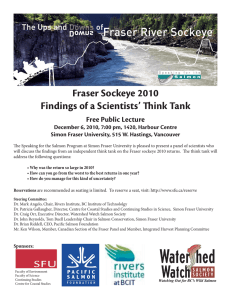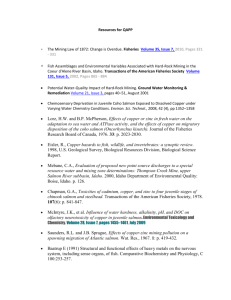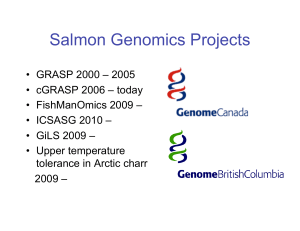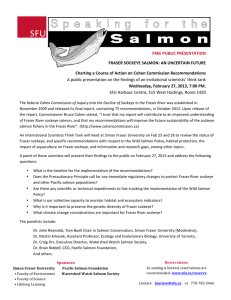Spotlight on legislation and policy protecting wild salmon biodiversity in BC
advertisement
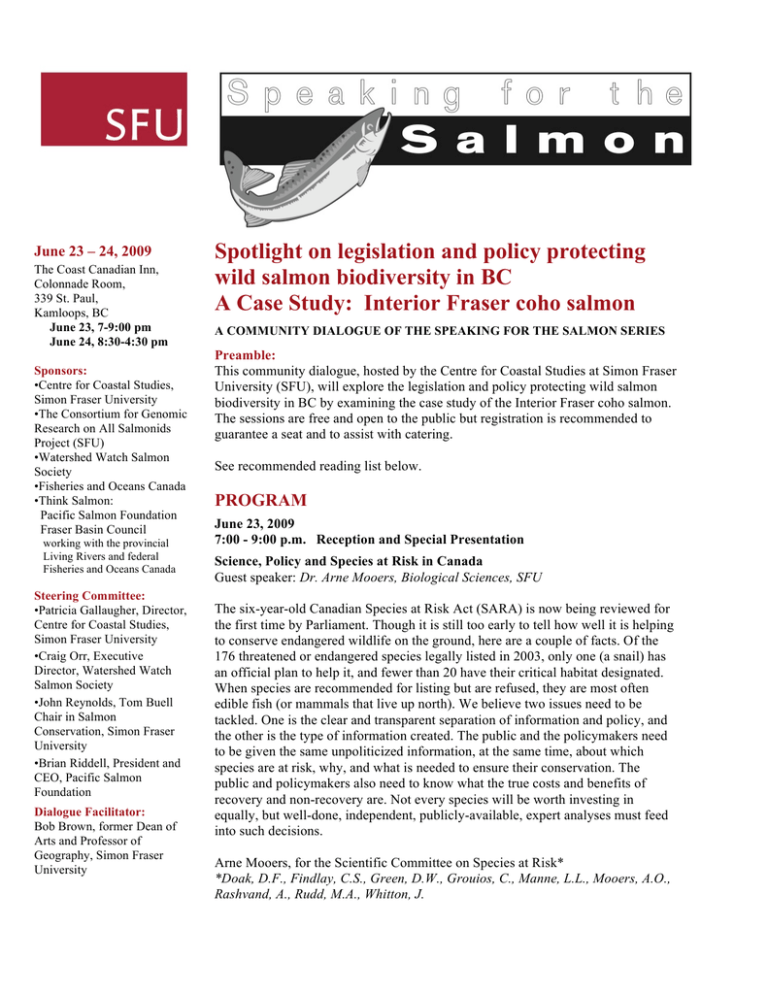
June 23 – 24, 2009 The Coast Canadian Inn, Colonnade Room, 339 St. Paul, Kamloops, BC June 23, 7-9:00 pm June 24, 8:30-4:30 pm Sponsors: •Centre for Coastal Studies, Simon Fraser University •The Consortium for Genomic Research on All Salmonids Project (SFU) •Watershed Watch Salmon Society •Fisheries and Oceans Canada •Think Salmon: Pacific Salmon Foundation Fraser Basin Council working with the provincial Living Rivers and federal Fisheries and Oceans Canada Steering Committee: •Patricia Gallaugher, Director, Centre for Coastal Studies, Simon Fraser University •Craig Orr, Executive Director, Watershed Watch Salmon Society •John Reynolds, Tom Buell Chair in Salmon Conservation, Simon Fraser University •Brian Riddell, President and CEO, Pacific Salmon Foundation Dialogue Facilitator: Bob Brown, former Dean of Arts and Professor of Geography, Simon Fraser University Spotlight on legislation and policy protecting wild salmon biodiversity in BC A Case Study: Interior Fraser coho salmon A COMMUNITY DIALOGUE OF THE SPEAKING FOR THE SALMON SERIES Preamble: This community dialogue, hosted by the Centre for Coastal Studies at Simon Fraser University (SFU), will explore the legislation and policy protecting wild salmon biodiversity in BC by examining the case study of the Interior Fraser coho salmon. The sessions are free and open to the public but registration is recommended to guarantee a seat and to assist with catering. See recommended reading list below. PROGRAM June 23, 2009 7:00 - 9:00 p.m. Reception and Special Presentation Science, Policy and Species at Risk in Canada Guest speaker: Dr. Arne Mooers, Biological Sciences, SFU The six-year-old Canadian Species at Risk Act (SARA) is now being reviewed for the first time by Parliament. Though it is still too early to tell how well it is helping to conserve endangered wildlife on the ground, here are a couple of facts. Of the 176 threatened or endangered species legally listed in 2003, only one (a snail) has an official plan to help it, and fewer than 20 have their critical habitat designated. When species are recommended for listing but are refused, they are most often edible fish (or mammals that live up north). We believe two issues need to be tackled. One is the clear and transparent separation of information and policy, and the other is the type of information created. The public and the policymakers need to be given the same unpoliticized information, at the same time, about which species are at risk, why, and what is needed to ensure their conservation. The public and policymakers also need to know what the true costs and benefits of recovery and non-recovery are. Not every species will be worth investing in equally, but well-done, independent, publicly-available, expert analyses must feed into such decisions. Arne Mooers, for the Scientific Committee on Species at Risk* *Doak, D.F., Findlay, C.S., Green, D.W., Grouios, C., Manne, L.L., Mooers, A.O., Rashvand, A., Rudd, M.A., Whitton, J. Dialogue in Plenary Questions: • The first time socio-economics comes into play with SARA is the Regulatory Impact Assessment Statement. What is it, and how does it work? • Is there an argument to be made for changing the process so that either (i) more socio-economic analysis gets done earlier in the process, or (ii) listing happens without socio-economic analysis but with fewer provisions (e.g. on incidental take?), and recovery strategies and plans are created hand in hand with socioeconomic analyses? • Is there an argument for ranking species for conservation? • How does COSEWIC work now? • Why are scientists so worried about transparency, peer review and independence? • Why are fish and northern species denied listing? Is this justifiable? June 24, 2009 8:30 - 9:00 a.m. Refreshments Colonnade Room, Coast Canadian Inn 9:00 - 11:00 a.m. Part I - Is the COSEWIC and SARA legislation process protecting Interior Fraser coho? Brief review of early conservation concerns Review of 2002 listing by COSEWIC Review of 2006 Recovery Plan Current status under COSEWIC/SARA Dialogue 11:00 - 11:15 a.m. Break 11:15 – 4:00 p.m. Part II Protection of Interior Fraser coho under the Wild Salmon Policy 11:15 - 12:30 Description of Conservation Units Progress with Habitat Indicators Progress with Ecological Indicators Dialogue • How much diversity is enough (per CU)? • Are the designated CUs adequate for the task? • Do the indicators incorporate local and traditional knowledge? • What are the appropriate habitat and ecological indicators to monitor? 12:30 - 1:30 p.m. Lunch Part II continued 1:30 - 3:30 p.m. Applying the Wild Salmon Policy Strategy 4 to Interior Fraser Coho Details of recovery strategy Defining the lower and upper benchmarks for conservation and sustainability Perspectives on collaborative decision making from: • First Nations • Government Dialogue • How do we set benchmarks to conserve weak stocks and biodiversity? • Is the WSP adequate for the job? • Do we have adequate resources for enacting the monitoring plans? To implement the WSP? • How do citizens become involved in strengthening the WSP? • What is the role of enhancement in the WSP? • What is the role of the Province in the WSP? 3:30 – 4:00 p.m. Final session: Focus on recovery of Interior Fraser coho – Progress in meeting the target Background Materials: Recommended Reading List – available under “news and events” at: http://www.sfu.ca/cstudies/science/ Recovery Assessment Report for Interior Fraser Coho Salmon (Oncorhynchus kisutch) Fisheries and Oceans Canada, Pacific Region, Canadian Science Advisory Secretariat, Science Advisory Report 2005/061 The successful completion of scientific public policy: lessons learned while developing Canada’s Wild Salmon Policy. Environmental Science and Policy, 12, November 2008, 140-148, James R. Irvine, Fisheries and Oceans Canada. www.elsevier.com/locate/envsci Conservation Strategy for Coho Salmon (Oncorhynchus kisutch), interior Fraser River Populations Fisheries and Oceans Canada, Interior Fraser Coho Recovery Team, October 2006 COSEWIC Assessment and Status Report on the Coho Salmon Oncorhynchus kisutch, interior Fraser River population, in Canada Committee on the Status of Endangered Wildlife in Canada (COSEWIC), 2002 Canada's Species at Risk Act: An Opportunity to Protect "Endangered" Salmon www.fisheries.org Fisheries, December 2005 11-19

